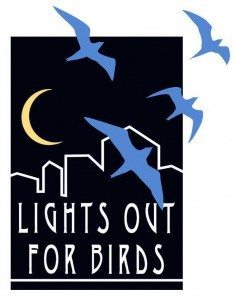Spring migration = Lights Out season
By Ilana DeBare
Three Canadian scientists set out to study the effect of human light on bird migration. They recorded the vocal activity of birds flying over unlit rural areas near the Great Lakes, and compared that with similar rural areas that had human lights at ground level.
They found nearly three times the number of calls by birds in the lit areas, according to their report in the May 2016 issue of The Condor, the journal of the American Ornithological Society.
The study didn’t pinpoint the exact reason for the increased calls. “Birds might have changed their migratory route to pass over lit areas, flown at lower altitudes over lit areas, increased their calling rate over lit areas, or remained longer over lit areas,” the scientists wrote.
But clearly the lights were affecting migrants in some way, a conclusion that was consistent with previous studies.
 This disruptive effect of urban lights on nighttime migrants is the reason for Golden Gate Bird Alliance’s semi-annual Lights Out for Birds campaign.
This disruptive effect of urban lights on nighttime migrants is the reason for Golden Gate Bird Alliance’s semi-annual Lights Out for Birds campaign.
As part of the Pacific Flyway, we have over 250 species — from tiny warblers to large raptors — passing through our region each year. Bright city lights may disorient them or lure them into deadly window collisions. So each spring and fall, we urge Bay Area businesses and residents to dim lights or draw shades at night to help keep these birds on route during their travels.
How can you help?
- At home, turn off unnecessary exterior lights between dusk and dawn.
- At the office, draw blinds if you’re working after dark. Or use task lighting such as a desk lamp rather than overhead lights that illuminate the entire area.
- Talk to your building owner or manager about turning off unnecessary lights or drawing blinds at night. Make sure the janitorial crews that serve your office are informed about Lights Out. Our Lights Out web page has flyers you can share with your employer, janitorial crews, and colleagues, as well as info on PG&E rebates.
Lights Out at work is particularly important because large office buildings can create masses of light that are visible to birds at a distance. Plus companies can benefit from adopting a Lights Out policy! Turning out unnecessary lights saves energy and reduces utility bills. PG&E offers business rebates on devices such as lighting timers or motion detectors that can reduce unnecessary night lighting.
Need more motivation? The Fatal Light Awareness Program in Canada has played a lead role in calling attention to the problem of bird-building collisions. Each year, their volunteers collect birds killed in collisions and create an educational display out of them at the Royal Ontario Museum. Here’s a video of their 2015 display.
It’s heartbreaking… but also an inspired way to turn those sad little bodies into an eye-opening educational message and a conservation challenge.
For more information on Lights Out for Birds, see goldengatebirdalliance.org/lightsout.
